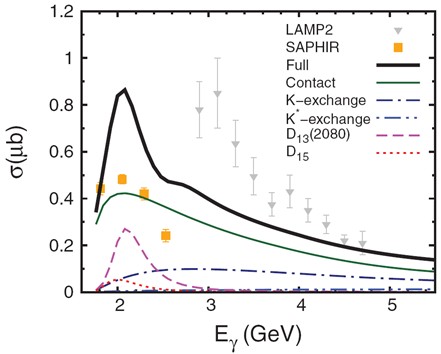By analyzing the experimental data of Λ(1520) photoproduction off a proton target, the researchers in Institute of Modern Physics, Chinese Academy of Sciences (IMP) have found that the nucleon resonance [N5/2-]2(2080) predicted by the constituent quark model(CQM) is important for reproducing the experimental data besides the dominant D13(2080).
After many years of efforts, the experimental data for nucleon resonances below 2 GeV has been accumulated while data above 2 GeV are still scarce. Due to the high threshold of Λ(1520) production, about 2 GeV, it is an appropriate channel for studying the properties of nucleon resonances, especially those with mass larger than 2 GeV.
In recent years, excited by the claimed finding of the pentaquark Θ with a mass of about 1.540 GeV, many experiments, such as LEPS/Spring-8,CLAS/JLab, have been performed in the Λ(1520) energy region due to the close mass of Λ(1520) and Θ. Though the existence of the pentaquark is doubtful based on later more precise experiments, many experimental data on Λ(1520) photoproduction have been accumulated.
The researchers in IMP have explored the role played by the nucleon resonances in the Λ(1520) photoproduction off a proton target within the effective Lagrangian method, taking into account the important nucleon resonances predicted by the CQM, and found the results are well comparable with the experimental data.
The results shows that D13(2080) is the most important nucleon resonance in Λ(1520) photoproduction and is responsible for the bump structure in the LEPS10 experiment. A nucleon resonance [N5/2-]2(2080) predicted by the CQM with mass of about 2100 MeV, which cannot be assigned as N(2200), is also essential for reproducing the experimental data around 2.1 GeV. Other nucleon resonances are found to give small contributions in the channel considered in this work. With all the important nucleon resonances by the CQM, the prediction of the differential/total cross section at energy up to 5.5 GeV is presented also (Fig.2); these can be checked by future experimental data in the CLAS eg3 and g11 runs.
The results have been published in Phys. Rev. C 86: 035204 (2012).
The article can be linked as follows: http://prc.aps.org/pdf/PRC/v86/i3/e035204

Fig.1 The differential cross section for the Λ(1520)photoproduction (Image by IMP)

Fig.2 The total cross section for the Λ(1520)photoproduction (Image by IMP)

